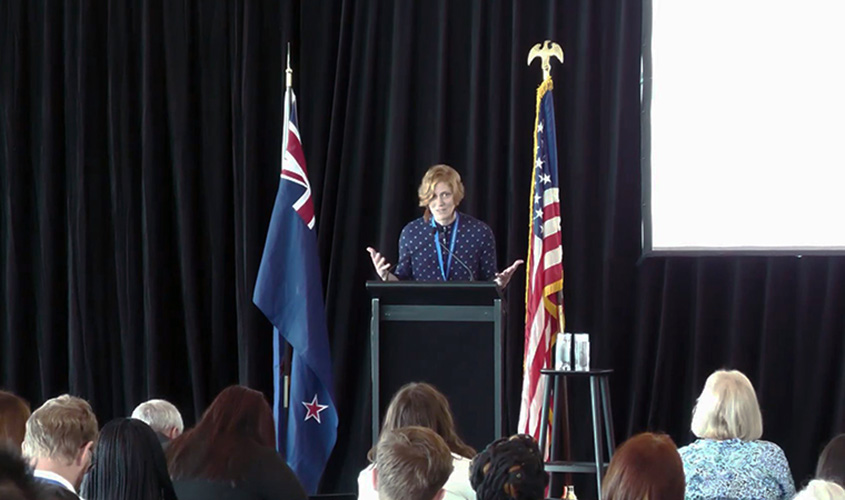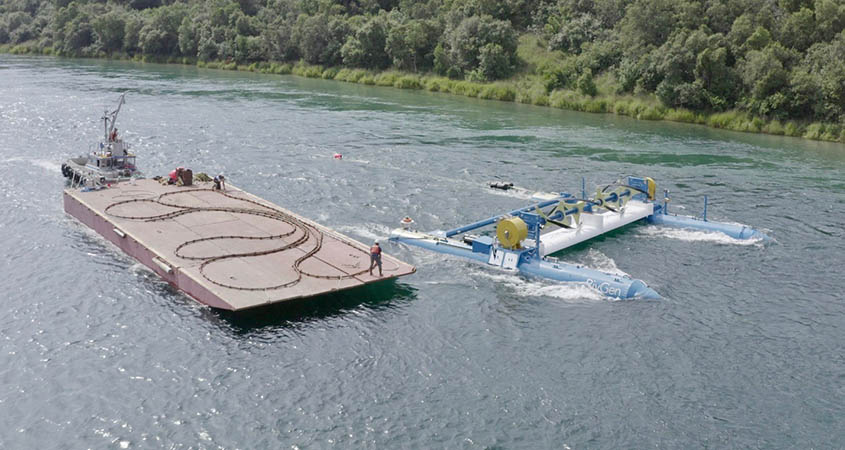How To Be a 'Good Ancestor'
At New Zealand’s First Clean Energy Conference, NREL Joined U.S. and New Zealand Experts and Leaders To Discuss Social, Financial Hurdles to Decarbonization
Near the north tip of New Zealand’s moon-shaped island nation, the sea pinches the land at a place called Tāmaki Makaurau, which means “Tāmaki, desired by many” in the language of the Indigenous Māori people. It is an accurate moniker. More than half of the Tāmaki Makaurau region is either green or blue. Lush grasses cover the volcanic hillsides, and mighty surf crashes along its coastlines. The Māori people call themselves tangata whenua, or “people of the land.”
But now, that land is in danger. Climate change is already wreaking havoc on Tāmaki Makaurau’s weather and waters, causing more extreme storms, flooding, and rising sea levels.
That vulnerable beauty made it a fitting location for the world’s first Blue & Green Technology Conference, held in December 2022.
Sponsored by both the U.S. Department of State and Auckland UniServices Ltd., a research and commercialization company based at The University of Auckland in New Zealand, the conference was designed to connect clean energy technology experts, as well as government and community leaders, from the United States and New Zealand—and, in so doing, help hasten the global transition to a low-carbon and climate-resilient future.
“Both our countries care deeply about being good environmental stewards,” said Thomas Stewart Udall, the U.S. ambassador to New Zealand, during the conference’s opening session. “Climate change is an existential crisis, particularly in the Pacific, and this conference is about exploring smart solutions, working together to face the challenge head-on.”
The National Renewable Energy Laboratory’s (NREL's) Tessa Greco was invited to share solutions during two conference sessions, titled “Community and Indigenous Innovation” and “Energy Futures.” Greco, the Strategic Innovation and Outreach subprogram manager and hydropower group manager at NREL, joined speakers from technology startups, Indigenous communities, and the highest levels of government. (New Zealand’s then-Prime Minister, Jacinda Ardern, opened the conference with a virtual welcome.)

Greco spent more than a decade managing and guiding renewable energy research—from water power to wind energy, solar power, batteries, and power systems engineering. In the first session, she and her fellow speakers discussed what clean energy experts can learn from Indigenous communities and cultures, like the Māori, who believe in “being a good ancestor,” as panelist Daniel Hikuroa, a senior lecturer at the The University of Auckland, said. The Māori already prioritize the preservation of their rivers, mountains, and trees for future generations.
“Being a good ancestor is a mindset consistent with a worldview that sees you as part of nature, not apart from nature,” Hikuroa said.
The panelists also discussed the need for Indigenous communities to lead their own clean energy transitions. “The fly-in-fly-out model is not acceptable,” Greco said in her talk. She described the U.S. Department of Energy’s Energy Transitions Initiative Partnership Project, through which technical experts work with remote and island communities in the United States to help them achieve their clean energy goals—or, as Hikuroa might say, be good ancestors.
In Greco’s second session, she joined presenters from technology startups, climate nonprofits, and companies working to harness waste, offshore wind, and wave energy—the “blue” tech referenced in the conference name.

Greco also explained how the U.S. Department of Energy uses prizes, which are administered by NREL, to invest in researchers, entrepreneurs, and community members who typically cannot access traditional funding opportunities. In the Waves to Water Prize, for example, participants competed to design a device capable of generating clean drinking water from seawater, using the power of the ocean itself.
“We had some great success and also faced some big challenges,” Greco said, adding that, during the final open-ocean test run, all four devices broke free of their moorings. “During the final test, the ocean proved to be a formidable foe. But in that struggle with nature, we have learned so much.”
Through this and future Blue & Green Technology Conferences, New Zealand and the United States plan to continue swapping successes and failures—whether those are in research, community partnerships, or investment schemes. The United States, Greco said, can learn from New Zealand’s efforts to harness their robust geothermal resources and from the country’s native communities, as they take charge of their energy transitions. The United States, on the other hand, can provide New Zealand companies and researchers with the resources they need to test their green and blue technologies on a larger scale.
“Everyone needs to come to the table,” Greco said.
Learn more about the support NREL offers to Indigenous communities. And check out the laboratory’s latest advances in water power. Subscribe to the NREL water power newsletter, The Current, to make sure you do not miss a water power update.
This article has been updated to reflect an editorial change made after its original publication.

